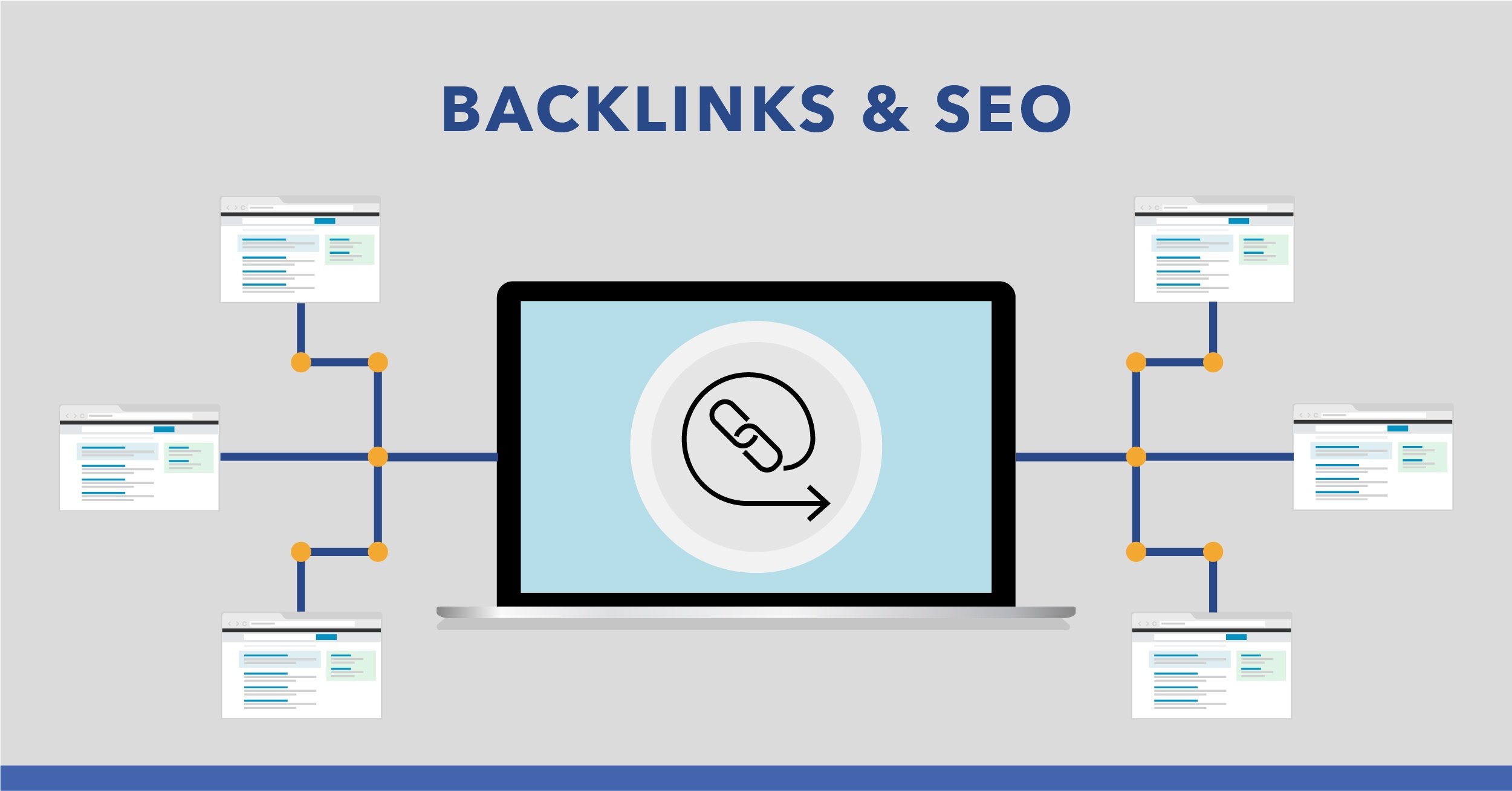Anyone whose business features an internet presence in some way has probably heard of SEO, or “search engine optimization,” at some point. With all the other concerns that come with keeping a company up and running, though, it is easy to let SEO fall by the wayside.
In the private sector in the 21st century, though, neglecting SEO is not an option. With a generation of digital natives joining the consumer spending economy, taking the top search engine spot for your industry keywords is the difference between leading the pack and playing catch-up. From a dollars-and-cents perspective, robust SEO translates into conversion numbers fed in from web traffic.
This article will cover a lot — use the link table below to easily jump to each respective section. You'll learn about our URA approach to SEO: usability, relevance, and authority.
|
Usability |
Relevance | Authority |
|
|
To get a sense of the scale at stake, Google users are submitting 40,000 searches per second or 3.5 billion searches per day. And with Google searches making up 93% of all real search traffic (i.e. submitted by humans rather than bots), those are numbers you can’t afford to leave out of your online strategy.
This makes an even bigger impact for e-commerce: When it comes to e-commerce sites, among our clients we have observed that at least 30% of their revenue originates with organic search.
Watch a quick, 5-minute video on the background of SEO:
At the same time as SEO has become more critical to businesses online, the task of leveraging SEO has also taken on new dimensions. The days of stuffing keywords on a page and buying links are long gone, and with the average number of pages to a site in many cases growing into the thousands, this multiplies the effort required.
There is a lot to manage when considering a comprehensive SEO plan, but there are a few SEO basics that you can start within your organization regardless of experience level.
What is SEO?
There are a lot of competing definitions on the web for search engine optimization, but in essence, SEO is the practice of optimizing a website so users can find it organically when searching for relevant keywords using a search engine.
What do we mean by organic?
Well, when a user searches for something on a search engine like Google, the results that populate the page can be advertised listings (paid) or free listings (organic).
The page you see after entering your search phrase, or query, is called the search engine results page, or SERP. Here is an example of the SERP for the query “best running shoes.”

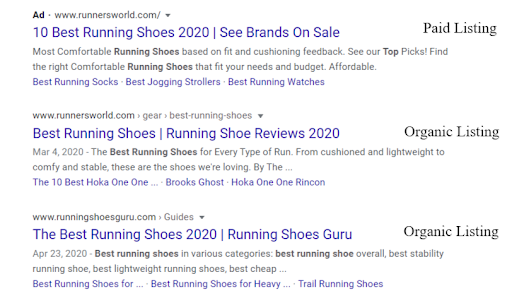 (SERP results for the query "best running shoes.")
(SERP results for the query "best running shoes.")
The top listing is an advertisement, as indicated by the “Ad” sign in the upper left corner. This means that the company pays for their listing to appear on the SERP for this specific query. The other two listings, however, are organic. The only thing that got these two listings onto the results page is their optimized content.
That’s what SEO is all about, and why it’s so important: you can drive traffic to your site and get conversions without having to directly pay for that traffic. While SEO isn’t free (you still need to pay people to optimize your website) there’s no direct payment for traffic as there is with paid search.
So, how do you optimize your website so you can land on page one of Google?
SEO is no longer about including as many links as you can find, but about building the best content experience for your target audience. In other words, SEO is about making your site the best answer to the question users enter into the search engine.
This is a significant pivot away from what SEO has been for a long time, and part of what makes our approach unique. We believe that SEO success comes from providing users with rich and relevant content at every step of their online experience, rather than from skewing page content to game algorithms.
In essence, next-generation SEO is fundamentally content marketing or, rather, solid content marketing creates good SEO.
So where do search engines come into the picture?
Google's Ranking Factors
In its primitive early days, Google’s search engine surfaced pages purely on the number of times a search term appeared on a page and the number of links to and from that page.
Since then, Google has developed a massive web-crawling infrastructure and finely tuned search algorithm to return much more intuitive matches to queries. Keyword matching and links haven’t been thrown out completely, and keyword research is still an important ingredient to SEO, but they are now supplemented by analysis of other HTML elements, synonym matching, UI layout, content type and much more.
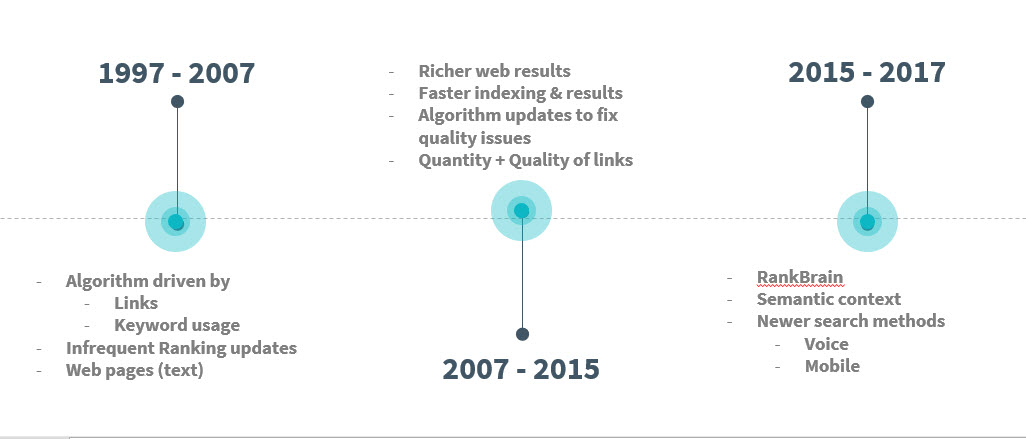
(Image Source: seoClarity Google’s History Summary.)
In fact, the Google search algorithm is comprised of hundreds of ranking factors that constantly shift and update based on the search results. The scale and complexity of Google’s operation is now so massive that an estimated 500 to 600 changes are made to Google’s search algorithm every year.
This massive expansion in scope is all in pursuit of returning the most valuable information for addressing every user’s intent. In fact, this focus on the user is what drove Google to offer a range of services beyond search such as Gmail, Google Maps, Google Drive, YouTube and much more: With every service, Google can answer a user’s questions that much more accurately.
But as you'll come to learn, chasing the algorithm to get ahead is not the most sustainable approach to SEO.
The inner workings of their algorithm are not all that Google has changed. The search engine results page, or “SERP,” has adapted with the algorithm. As even novice internet users now come to expect, Google always strives to place the most relevant result at the top of the search results, but their modern SERP does so much more.
Just look how the SERP for the keyword "hotels" has changed over the years:
Relevance, and therefore placement, is now also determined by the context in which Google locates query keywords, and spot-on matches are even given specialized content boxes inline or to the right of ranked query results.
You’ve probably noticed things like People Also Ask, Image results, Video listings, and the Answer Box/Featured Snippet appear directly on the results page. These SERP features were built to offer the end user a more positive search experience — which is precisely Google’s main goal. The search engine wants to give its searchers the most relevant information in the most intuitive way.
So far, we’ve discovered more than 1,200 of these SERP features, so it’s no exaggeration to say that SEO is a constantly changing industry.
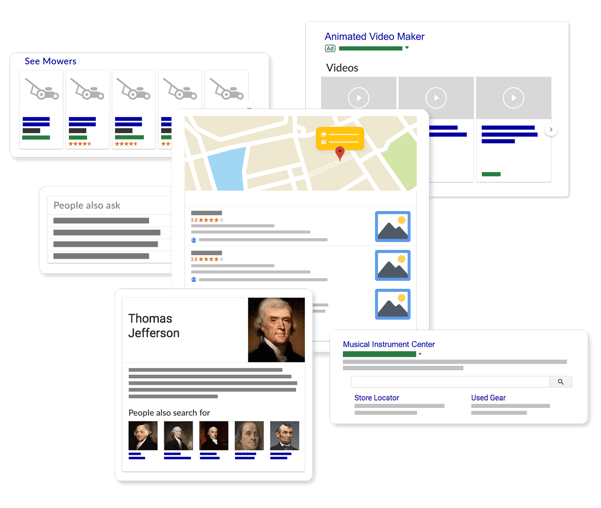 (Different SERP features present information in unique ways.)
(Different SERP features present information in unique ways.)
Because of its massive market share, Google is the search engine that matters most in SEO. After all, it’s where most people search. (It’s actually the largest search engine in the world, followed by YouTube.) Other search engines like Bing can be a part of organic search endeavors, but a focus on Google is the most strategic path to take.
A Simplified Approach to SEO
At seoClarity, we have an established framework to establish a solid SEO strategy that allows you to give the end user a positive search experience. Because it’s not just Google’s goal to offer a positive experience — it should be yours too!
That’s why we like to think of SEO as search experience optimization.
When you offer something useful to searchers, they will click to your site more often and stay on your site longer. Google will realize that your site is a good resource to its users and will give your website listing a good ranking on the SERP. When the end users are happy, everyone wins.
So, what is our approach? It follows a simple acronym: URA.
Usability, Relevance, and Authority serve as the framework for creating search experience optimization.
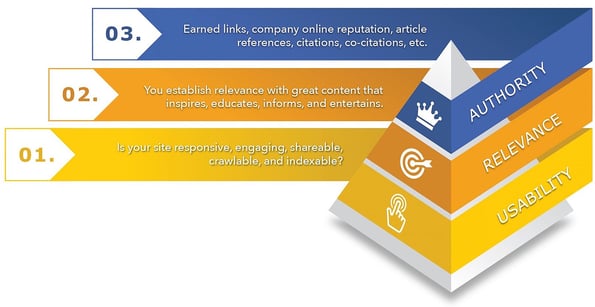 (The URA framework to SEO includes usability, relevance, and authority.)
(The URA framework to SEO includes usability, relevance, and authority.)
Usability
The first step in creating a positive end user experience is to ensure that people (and Google) can properly access and navigate the site. Having a sound structural foundation lays the groundwork for the content users will search for.
Crawling and Indexing
When you create a website, one of your goals is to drive traffic to it so you can score leads and conversions. But, no one will be able to find your site on the SERP if it’s not in Google’s index.
This is where the idea of crawling and indexing comes into the picture. Crawling is when Google sends its web crawler, Googlebot, out on the web to read pages and collect information on them. Googlebot uses internal links (those hyperlinked texts that usually appear in blue; they link from one web page to another page on the same site) to travel from page to page on the website. When Googlebot collects this information, it adds the pages to it’s index: a huge database of information that it has collected from the web.
So in order to appear on the SERP, you need to have your site crawled and indexed; and in order to have your site crawled and indexed, you need to have a fully functional website. That’s why usability is the first step in our framework.
To see if site’s content is indexed, type the following query into the Google search bar:
“Site:YourSite.com”
Here’s how that looks for our site, seoClarity:
 (Testing a URL for indexation.)
(Testing a URL for indexation.)
If you see results on the page, congratulations! Your content has been indexed. If not, it could be because Google’s crawler just hasn’t reached your pages yet, or your IT team may have robots.txt set up on your site that have blocked the site from being indexed.
Robots.txt can block a crawler from viewing certain pages on your site. Why would anyone want to block their pages from appearing in Google’s index, you ask? Well, certain pages (like those with personal information or specific log-in pages) have no reason to be on the SERP, so a robots.txt file limits Googlebot from accessing those pages. This also saves the crawl budget, because a crawler will only spend so much time on any given site.
If none of your pages appear on the SERP, however, talk to your technical team to see if any parameters are blocking Googlebot.
Page Speed
When your site is able to be seen on the SERP, you’re one step closer to having users click to your site. But even if users do see your listing and decide to click it, they won’t stay on the page for long if it doesn’t load quickly.
You’ve probably encountered this yourself: You get to a webpage and it doesn’t load, so you immediately leave the site (or bounce) and click another listing on the SERP. It makes total sense; users want a positive search experience, and slow load times are not a part of that.
To have users stay on your site, aim to have your web pages load in two seconds or less. The quicker, the better.
If you use an enterprise SEO platform, it should have a page speed score or report that you can reference to see which pages are lacking in terms of load time.
Hot Tip: If you haven’t invested in an SEO platform but are interested in learning more, we’ve compiled a list of some of the best SEO platforms on the market.
Site Architecture
Another crucial aspect of the usability portion of your site that lends itself to a positive user experience is the layout of your site. In SEO, site architecture is known as site taxonomy.
Your site should have an intuitive nature to it, so make sure your important pages are only a few clicks away from your homepage. You have this great information to offer, so don’t let it get lost in the depths of your website!
And not only will a proper site taxonomy help users find your content, it is also beneficial to Googlebot, which is following your site’s interlinks to get to the next page. Don’t make Googlebot’s life harder: Ensure it can easily navigate to your most important pages.
Do note that the ideal site taxonomy will vary by industry. An ecommerce site, for example, will most likely be set up differently than a blog. The kind of website you operate will make a big difference in the mind of the user with what they expect the site to look like.
Sitemap
A sitemap is a file that houses all the information on the pages of your site, its files, etc. Googlebot uses this site map to see the connection between pages and determines which pages are the most important based on how the sitemap is set up.
For this reason, you should include your most important URLs in your site map. To see what your sitemap currently looks like, enter the following into the address bar:
“www.sitename.com/sitemap.xml”
There’s no guarantee that this is where your sitemap is located, but it’s a good place to start. You’ll know if you’ve found the sitemap file if you see what is called a “document tree” of different URLs.
If the URL ending “/sitemap.xml” doesn’t work, then try to adjust the URL to “/sitemap” or “/sitemap_index.xml”.
The reason being is that some sites have their sitemaps tucked away in different areas than others.
Because they’re so important, some SEO crawler tools can generate sitemaps for you. Our crawler, Clarity Audits, is one capable of this.
HTTPS
You’ve probably noticed that some sites’ URLs are prefaced by HTTP, while others begin with HTTPS. This stands for HyperText Transfer Protocol — but the important thing here is Secure.
Even if a searcher didn’t know the difference between the two versions within the URL, web browsers like Google Chrome now alert users if a website is secure or not.
A padlock icon appears on the far left-hand side of the address bar for secure pages, and shows users that the site is safe. This is crucial for end user experience — users may bounce from a page that’s not secure out of safety concerns for their information and data.
If a page is not secure, Google Chrome may also flash a full-page alert that warns the searcher that the page is not secure. This is a big red flag for many searchers, which causes them to bounce from your page back to the SERP.
Summary
Usability covers everything from structuring your HTML elements to reinforce user search relevance, to making sure your page can be crawled, loads quickly and has an intuitive hierarchy. Be sure to clean up any lurking 404 errors or indexing mismatches, too, as this shows attention to detail and prevents the disruption of the site experience. How do you put this into action?
Refine your user experience and site performance. Reassess how the site looks and behaves. Is it easy to navigate around? Does it look legitimate or trustworthy? Would users who find the page stick around? Does the site load quickly and work properly? If the answer to any of these questions is “no,” there is still work to be done. This angle is what we call technical SEO.
To dive deeper into technical SEO problems (and their solutions), we recommend this resource: 15 Common Technical SEO Issues and How to Solve Them.
Relevance
With so many websites and so much content out there, it’s critical to stay relevant to what your end user searches for. Always keep your audience in mind when you create content. After all, no one wants to click a listing that won’t answer their query appropriately.
Keyword Research
All SEO content writing needs to start with proper keyword research. When you conduct keyword research, you learn how your audience searches for the topic that you want to create content around.
It would be a waste to create great content only to realize that the page is optimized for a keyword that has no search volume. And if no one searches for it, that means that content was created that provides no value to the end user.
When you conduct proper keyword research, however, you uncover terms and topics that can connect your site to the customers’ online search journey — which positions your website as a viable resource to click.
Keyword Portfolio Management
There’s an endless amount of keywords out there (Google even notes that 15% of all search queries are never-seen-before terms) so it’s critical that you select keywords that are relevant to the content that you aim to create.
Having a relevant keyword portfolio means that you can get your content in front of your target audience. When you understand how they search, you learn what to focus on.
There are many ways to create your golden keyword portfolio, but we’ve simplified the process into the BOBs approach: Benchmark, Optimize, Build, and Special Projects. To learn more about the BOBs approach, navigate to this resource: Create the Best Keyword Portfolio With This Acronym.
User Intent
Addressing the right user intent is a major factor that determines if a user clicks your link (and if Google even puts your page on the SERP). Each query can be categorized into one (or more) of the following intents:
- Informational
- Transactional
- Navigational
- Local
When you create content around a keyword and topic, you need to ensure that the content matches what the user is looking for (i.e. relevance). If a user’s query is “how to tie a tie,” they most likely want an informational blog or video that explains how to do so; not a website that sells ties.
If you have an understanding of the different kinds of intents and how it connects to the searcher’s journey, you’re one step closer to creating relevant content that resonates with the end users.
Content Mapping
To ensure relevance for the end user at all stages of their search journey, it’s important to conduct content mapping.
When you create (or enhance) your content to address each stage of the buyer’s journey, you position your content in front of the searcher in multiple ways and increase your search visibility.
Your content is no longer seen in the just awareness stage of the buyer’s journey, for example, but rather all three stages: awareness, evaluation, and decision. Your website becomes a resource for searchers in multiple ways, which shows them that you are serious about providing value to their online experience. To learn more about content mapping, we recommend the following resource: Finally Reach Your Target Customers With Content Mapping.
Summary
We keep coming back to this because it should be your top concern. Go the extra mile, from providing a rich resource for searchers to catering to every step in the journey you want them to have. Make your site the best answer to your users’ questions, for as many people as possible. Put this into action:
Tighten up your content. Effective SEO always returns to content and the value of that content. Scour every blurb and make sure that it is all crafted with relevance to the user in mind.
Authority
Once your website is set up to provide a positive end user experience, and your content is relevant to your audience, it’s time to demonstrate your authority on the topic. This will establish you as a trusted source for information within your space, which shows the value that your website provides to users.
Topic Clusters
Research what topics your target audience searches, and create content to be relevant for every cluster around that topic. When you cover a topic from multiple perspectives, you strengthen your topical authority. Then, interlink those assets to connect them. This shows that you have a holistic understanding of the topic at hand. Here’s a diagram of what that would look like:
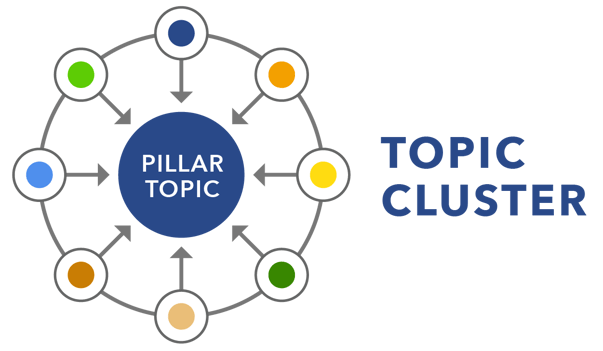
Recommended Reading: What are Topic Clusters? Increase Search Visibility By Building Authority on Any Topic.
Content Optimization
A few small tweaks can boost your search visibility and authority. First, in the ever-changing world of SEO, it’s important to note that frequent usage of a keyword on a page is not sufficient for demonstrating your knowledge to the users (or Google, for that matter).
If you find yourself ready to drop basic keywords all over your pages, this is where your SEO strategy needs an overhaul. Instead, focus on semantically related keywords. For example, if you have a page on engagement rings, you’ll want to include terms like carat, diamond cut, platinum, etc.
The inclusion of these keywords demonstrates your understanding of the topic, and this extensive information is going to prove useful for your audience.
To further optimize your content and demonstrate authority, include statistics, citations, and other relevant, reputable information like quotations to enhance the credibility of the content.
Now, it’s time to factor that answer into the nuts and bolts of your page. Scan through your page and make sure your meta tags, title tags and heading tags (H1, H2, etc.) are filled with content that answers the query.
For a more in-depth look at writing SEO content, we recommend the following resource: How to Write Authoritative Content that Boosts Rankings and Engagement.
External Links
Although outside of your direct control, external links boost your page’s authority level because they show that others see your content as a valuable resource. Where internal links are hyperlinks that take you to another page on the same website, external links, or backlinks, are links from other websites that link back to your own.
The key to earning backlinks is to create high-quality content that someone else would want to reference. Or, make your content stand out in some way. Maybe you have an exclusive quote, or are presenting recent research findings. (Creating optimized content and backlinks go hand-in-hand.)
You can also monitor when your brand is mentioned by using a tool like Google alerts. This tells you whenever your brand is written about online. Let’s say, for example, a publication includes you in a story on the top brands to know, but they don’t link to your website. You can kindly reach out and ask them for the backlink. This small gesture can go a long way in demonstrating your authority.
Summary
Beyond being an authoritative voice in your industry, the final set of tasks within our framework are centered around link building. Create original content that is link-worthy and structure your site so that the most important content is easy to find via internal links. Once you’ve done that, keep the content coming, and keep the content fresh! No matter what, put the best of what you have to offer front and center. Move into action, but only after Usability and Relevance are covered.
Be an authority. Is the content useful enough to link to? Do other authoritative sites use that website as a reference or citation? You want the answer to be “yes” as much of the time as possible, and having even a handful of pages that achieve this will give your site a lot of traction.
SEO = Content, or Content = SEO
This is probably evident by now, but it bears repeating: There is no SEO without attention to content. Here are some summary points on how to create the best content possible.
Recommended Reading: 19 SEO Content Writing Tips: Create Copy That Both Google and Users Love
Produce Engaging, Accurate Content
This starts with writing great page titles and extends to meta descriptions. The first line of content your audience sees is also a top consideration for search engines, so effort should be invested accordingly. Feature catchy and clickable headlines and page titles and rich meta descriptions that accurately describe what the page is about. This also helps social media shareability — both right from the page or through viral posts within the different social media sites. All of this should be viewed from a perspective that makes your information actionable — if your content doesn’t drive user decisions or outcomes, its value is limited.
Include Different Content Types
Every word should be directed at the target audience’s search intent. If a query is transactional, make sure the page explicitly and easily enables that transaction. If a search query is informational, this usually requires a blog post type of format that includes the informative content that your reader would want, with links to any supplemental material. Also, don’t forget the power of video.
Keep a Close Eye on Content Length
Present content with variable length. Sometimes a high word count is best, and sometimes it’s not. The right approach is the one that best addresses user search intent, and meets the need that led them to the site in the first place. Have you provided all the information about the product they could possibly need to make the decision to move forward? If not, you leave the door open for them to return to the SERP and turn their attention somewhere else, losing a potential conversion.
Design Mobile-First Content
Ensure that your content is viewable, and maintains a smooth UX, on a small screen. With an ever-expanding share of web visits coming from mobile, the mobile experience has to be considered, and polished, from day one.
Create Link-Worthy Content
Publish original research studies, statistics, user-generated content and anything else that reinforces your authority and credibility as an online resource. This invites others to link to you, rewarding you not only with a better search ranking but organic referrals via links. Another way to give a page authority is to create topic clusters around this pillar topic with powerful anchor text with thoughtful internal linking strategy.
The Scalability of Enterprise SEO
SEO is not something you can grow overnight, and this is especially true the larger your organization is. This shouldn’t stop you from getting started, though. It just means starting simpler and letting constructive SEO habits take hold a little at a time, building up credit and credibility within your organization. Here are ways you can plant and nurture SEO within your organization, regardless of size.
Simplify: How you think about SEO matters. It’s important to start by making the paradigm shift from focusing on search engines to focusing on users, and once you make it, user-centric SEO outcomes will slowly but surely follow. This can be accelerated by letting this philosophy guide interdepartmental work and devising of business goals. Once everyone is front-loading customer experience, SEO starts to permeate your online presence.
Structure: After making the above transition, how you then approach the hard work of doing SEO matters. This means charting out a roadmap of how to roll out your SEO strategy and create a clear vision of what bases need covering for every page that goes up, every process you implement, and every team that makes changes on your site.
Scale: Finally, how you accelerate SEO matters. User- and content-focused SEO and content structure maps set the stage for implementation, which depends on synchronized efforts across teams. This requires every team working from a single source of truth. This includes technology, an SEO platform that provides reliable data-driven insights for the team to implement that user-focused content with ease, check the user experience and site health, and access to the KPIs and metrics to implement consistent and repeatable SEO success that allows them to scale their efforts.
Key Takeaways
Focus on your user's experience instead of the search engines algorithms. The search engines' goal is to deliver the best experience for their users: enable them to leverage your content by doing the same!
Simplify your approach to SEO with the Search Experience Frameworks of usability, relevance, and authority.
Once your team is structured with the end-user in mind, ensure all teams are aligned around the data and metrics that serve as the single source of truth. Leverage data-driven insights to scale your SEO success with consistent results.
Further Resources
The following articles are great next steps to see how you can make an investment in SEO. For other resources, take a look at our Learning Center.
- What are the Best Enterprise SEO Platforms?
- What Are the Best Keyword Research Tools?
- What Are the Best Site Audit and Crawler Tools?
- What Are the Best Keyword Rank Tracking Tools?
SEO Glossary
- Crawling: Crawling is when a web crawler like Googlebot navigates the web to learn about web pages and their content.
- External Links: External links (also known as backlinks) are hyperlinks from one website that lead to your website.
- Googlebot: Google’s web crawler that gathers information on the web pages and adds that information to Google’s index.
- Index: Google’s database of information that Googlebot has collected. A web page must be in Google’s index in order to be found through organic search.
- Indexing: Indexing is Googlebot’s process of adding web pages to it’s index.
- Internal Links: Also known as interlinks, internal links are links that lead to another page on the same website.
- Organic Listings: Website listings that appear on the SERP through optimization tactics.
- Paid Listings: Listings on the SERP that have been paid for. Essentially, paid advertising in search.
- Ranking: The position of your SERP listing. (Do note that how we measure rankings changes as the SERP continues to evolve.)
- SEO: Search Engine Optimization, or as we like to call it, Search Experience Optimization. Optimizing your website for the best end user experience possible.
- SERP: Short for Search Engine Results Page, the SERP is the page you see after you make a query on Google. It houses the results.
- SERP Features: The SERP includes more information than just paid and organic listings. There are also Google-created features like the Answer Box, Knowledge Graph, Local Listings, and News.
- URA: seoClarity’s search experience framework consists of usability, relevance, and authority.




